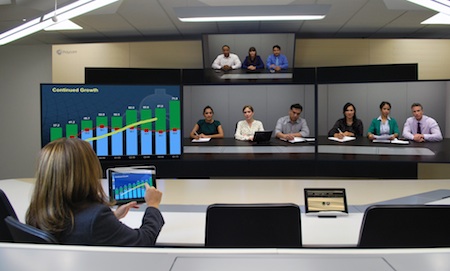While InfoComm 2013 was a milestone year for UC, 2014 is poised to build off last year’s innovations and demonstrate a maturing in the collaborative space. Kinks will be ironed out, and new tools will be introduced, including WebRTC, video content management, speech to text, metadata tagging, and big data analytics.
I spoke to John Antanaitis, VP of product marketing for Polycom, who told me that the most important thing about all of these improvements and advancements are their ability to provide new revenue streams for integrators. They are also reasons that make THIS InfoComm “a very important show, and a big opportunity for AV integrators.”
He emphasized that, “The forward thinking and educated and aware integrator can become a very critical adviser to their clients and help create the workspace of the future.”
The service oriented business model continues to evolve, with “video as a service” and “UC as a service” buzzwords both coming up as part of our conversation. The idea is that these services are leveraging solutions like Polycom’s CloudAXIS in the background.
Polycom’s RealPresence Immersive Studio allows users to see content on any display in the studio with support for BYOD and Polycom’s VisualBoard virtual whiteboard.
Clients can take advantage of these capabilities without the need for full blown in house expertise and the need to purchase everything and have it on premise, Antanaitis said. The integrator doesn’t need to create this service themselves, as would have been the case in the early days of collaboration tools. This is a white-labeled wholesale product available for integrators to sell and deploy.
The extension of video collaboration into the mobile realm will continue to grow with the ability to provide enterprise grade quality; meaning strong, stable, and secure video content across devices.
WebRTC was a major buzzword circulating at Enterprise Connect this March. Antanaitis expects it will still be valuable to see what different players are active in this web browser real time communications initiative. There are admitted challenges with WebRTC in respect to network connectivity and management for example; Polycom will be demonstrating ways to overcome these trials. The commoditization of videoconference is already happening, he noted, “but it’s going to expand the market pretty significantly,” because of opportunities for individuals to leverage browser based video collaboration.
Among the other new UC tools we’ll see, people are starting to think about the amount of information taking place in any collaborative session. Video content management, for example, can capture work sessions and share what’s important. Speech to text will translate everything that is spoken in the session into text. The result isn’t just a lengthy text stream; there’s metadata tagged to the text, which can be searched by anyone in an organization worldwide to basically continue and build on the collaboration in between formal meetings.
“Those analytics provide a wealth of information that should be shared and reviewed for benchmarking and comparison,” he said. There’s more analytics of this data going on now too. “Big data, in a unique fashion around the collaboration experience, is going to impact this event for years to come. I still think it is a nascent, young subject,” he noted.
Polycom will have a services station demonstrating data and analytics. Where in the past, services were about fixing something that is broken, “a few years ago, Polycom realized that we needed to do something beyond that,” Antanaitis told me. “We started building tools around analytic information.” What’s happening on the bandwidth, with utilization, and with network packets; how many calls are being conducted, how many of those are bridge calls, how many are successful? These are all subject to data analysis to assess if an organization is being fully effective.
Polycom gets data from the end user on a monthly basis, and as part of its structured service model (included with Polycom’s advanced and elite packages), they provide monthly feedback to an organization. On a semi-annual basis, Polycom takes that information and performs benchmarking surveys against peer groups. The company can then provide a data profile to end users identifying what the top and low performers are achieving for comparison.
The acoustics of remote and collaborative workspaces are another area Polycom is working on solutions for. We’ve all been working remotely—or on a conference with someone who is—when the doorbell rings, the dog starts barking, the landscapers are running noisy power tools outside. Polycom will be demonstrating a few ways to enhance audio and capture these acoustic bubble type scenarios.
The result of all these trends is that integrators shouldn’t be putting products into a system and thinking their job is done. When customers are more productive, integrators are more engaged and have greater opportunity to sell and grow the business.




